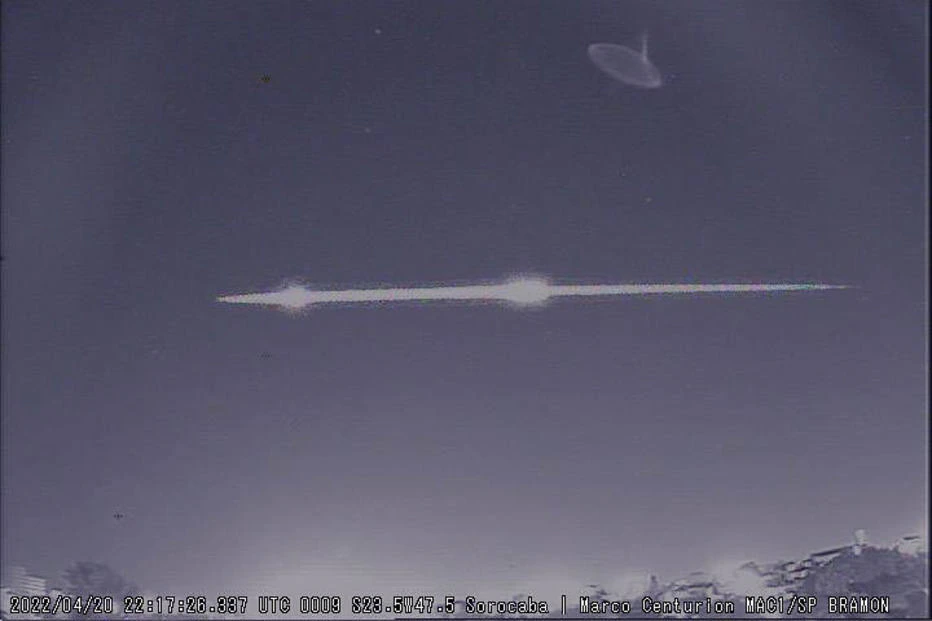A physicist records a double meteor explosion in the sky of Sorocaba; see photo – flag
3 min read

SOROCABA – A meteor exploded twice in a row, leaving a strange trail of light in the sky of Sorocaba, in the interior of Sao Paulo, on Wednesday, 20. Physicist Marco Antonio Centurion, 31, recorded the unusual phenomenon. The Brazilian Meteorite Monitoring Network (Pramón) maintains a monitoring station in his home, near the city centre. The pictures spread on social media.
The recording took place at 7:17 pm and lasted about six seconds, when the double meteor impact with the atmosphere lit up the sky of Sorocaba and impressed the physicist. “It’s not a rare phenomenon, but it’s completely uncommon and we have a very clear record of it,” he said. The records also impressed the Centurion Fellows at the Centauri Astronomy Club, a group of volunteers interested in astronomy.
It is believed that the double explosion was either because the meteorite had a denser mass or because it was a larger than usual celestial body. “The average size of a meteorite is equivalent to a penny. When it enters the atmosphere, it collides with the layer of gases in the atmosphere and heats up until it explodes and turns into dust. He explained that in this case, most likely, the first layer exploded and there was still mass left, it also glowed and was born The second explosion.
A similar phenomenon occurred at the beginning of the year in Rio Grande do Sul, according to the researcher. As a volunteer member of Bramon since 2020, he’s already recorded several meteors, but this is the first time he’s been able to catch a double blast at such a convenient angle. “I often joke that if I wanted to wish every meteor a common name for a meteorite, I would have had more than one a day. This record was different because my cameras were well positioned. Your station works with a camera pointed to the northeast and another to the West, both paired with a computer.
He will analyze the images with the support of Bramon as other observers have captured the same eruptions from other angles. This allows you to “triangulate” the data and determine the path of the meteor. The physics and mathematics professor said Centurion is passionate about astronomy and is the volunteer science director for the Centauri Astronomy Club, which was set up in 2014, in Itapetinga, as well as in the countryside. The club has more than 60 members.
Centauri is part of NASA’s Space Place program, the US space agency, and has already received a Certificate of Appreciation for its work in data collection and scientific publication on meteorites through lectures and on social networks. “We translate, localize (adapt to Brazilian conditions) and publish astronomy works that we receive from NASA. Our dream is for astronomy to become a subject in schools, like physics,” he said.
Cameras and telescopes point to the sky
Pramon Volunteers are scattered all over Brazil and keep their cameras and telescopes pointed at the sky and working every night. After recording, the player analyzes the captured images and shares them. Almost nothing escapes these strange gazes at the sky. On April 3 this year, a small asteroid exploded over the state of Amazonas, forming a large fireball in the central region of the state. Fragments from this meteorite may have reached Earth.
Bramon cameras in southern Brazil captured the re-entry of a Soviet spy satellite that had been in orbit for nearly 40 years. The fireball crossed the sky of Parana, Santa Catarina and Rio Grande do Sul, and disappeared on the border with Uruguay. Analysis of the videos concluded that it was the Cosmos 1437 satellite, launched in January 1983 by a Vostok-2M rocket, from Plesetsk, in the former Soviet Union. The expected date and time of return coincides with the registration of the burned object.
In August 2021, the passage of a large meteor caused an explosion and turned night into day, for a few seconds, in several states in the northeast. Several cameras recorded intense light, as if the sky was on fire. Bramon is an open and collaborative network, run by volunteers and supporters, with the goal of observing meteors, and producing and providing scientific data to the community. Its members have already recorded 3.9 million meteors and cataloged 126 radioactive ones – the points of origin of meteor showers.

“Entrepreneur. Music enthusiast. Lifelong communicator. General coffee aficionado. Internet scholar.”

:strip_icc()/s04.video.glbimg.com/x720/11792055.jpg)

:strip_icc()/s03.video.glbimg.com/x720/11786998.jpg)